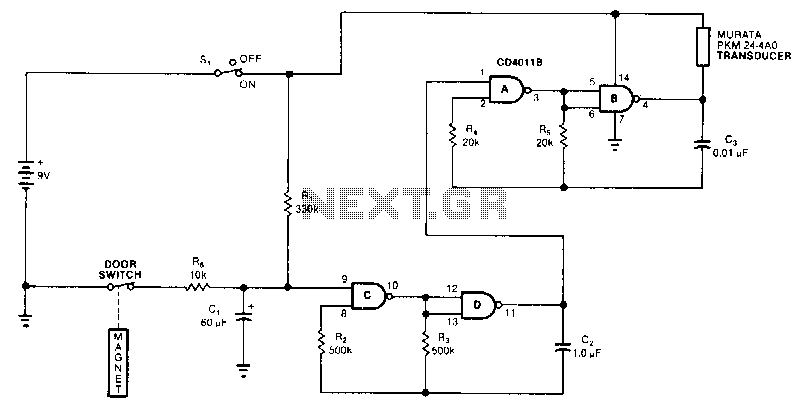
Door-ajar-monitor

The monitor detects when a door is left ajar and, if the door remains open for more than 20 seconds, it activates a beeping alarm. The circuit utilizes a magnetic reed switch paired with a magnet located on the door. When the door is closed, the switch remains closed, keeping the alarm disarmed. Upon opening the door, the switch opens, allowing capacitor Cl to charge through resistor Rl. After approximately 20 seconds, the voltage at pin 9 rises sufficiently to activate the oscillator composed of components C, D, R2, R3, and C2. This oscillator generates a 3-kHz pulse that drives a piezoelectric transducer. To reduce the battery's standby current consumption, it is recommended to replace Rl with a 66 MΩ resistor and Cl with a 1 mF film capacitor.
The described circuit operates as a simple door monitoring system, integrating a magnetic reed switch that functions as a sensor for the door's position. The reed switch is a critical component that closes when the door is shut, effectively preventing current flow through the alarm circuit. Once the door is opened, the switch contacts separate, initiating the charging process of capacitor Cl through resistor Rl. This charging process is time-dependent, allowing for a delay of approximately 20 seconds before the alarm is triggered.
The design incorporates a timing mechanism utilizing the charging characteristics of capacitor Cl, which, in conjunction with resistor Rl, determines the delay duration. When the voltage at pin 9 reaches a predetermined threshold, it activates a series of components (C, D, R2, R3, and C2) that form an oscillator circuit. This oscillator generates a square wave signal at a frequency of 3 kHz, which is then used to drive a piezoelectric transducer. The transducer converts the electrical oscillations into audible sound, alerting users to the open door condition.
To optimize battery life, modifications to the circuit can be made by using a higher resistance value for Rl (66 MΩ) and a larger capacitance value for Cl (1 mF film capacitor). These changes will reduce the current draw during standby operation, thereby extending the overall battery life of the device while maintaining functionality. The design effectively balances responsiveness to door status with energy efficiency, making it suitable for applications requiring reliable door monitoring with minimal power consumption.The monitor senses an ajar door and, if the situation isn"t corrected within 20 seconds, sounds a beeping alarm. The circuit is controlled by a magnetic reed switch and magnet on the door. With the door closed, the switch is closed and the alarm is disarmed. Opening the door opens switch, Cl starts charging up through Rl. Approximately 20 seconds later, the voltage at pin 9 is high enough to tum on the oscillator formed from C, D, R2, R3, and C2.
That pulses the piezoelectric transducer"s 3-kHz oscillator. For lower standby drain on the battery, change Rl to 66 M{} and Cl to 1 mF (film). 🔗 External reference
The described circuit operates as a simple door monitoring system, integrating a magnetic reed switch that functions as a sensor for the door's position. The reed switch is a critical component that closes when the door is shut, effectively preventing current flow through the alarm circuit. Once the door is opened, the switch contacts separate, initiating the charging process of capacitor Cl through resistor Rl. This charging process is time-dependent, allowing for a delay of approximately 20 seconds before the alarm is triggered.
The design incorporates a timing mechanism utilizing the charging characteristics of capacitor Cl, which, in conjunction with resistor Rl, determines the delay duration. When the voltage at pin 9 reaches a predetermined threshold, it activates a series of components (C, D, R2, R3, and C2) that form an oscillator circuit. This oscillator generates a square wave signal at a frequency of 3 kHz, which is then used to drive a piezoelectric transducer. The transducer converts the electrical oscillations into audible sound, alerting users to the open door condition.
To optimize battery life, modifications to the circuit can be made by using a higher resistance value for Rl (66 MΩ) and a larger capacitance value for Cl (1 mF film capacitor). These changes will reduce the current draw during standby operation, thereby extending the overall battery life of the device while maintaining functionality. The design effectively balances responsiveness to door status with energy efficiency, making it suitable for applications requiring reliable door monitoring with minimal power consumption.The monitor senses an ajar door and, if the situation isn"t corrected within 20 seconds, sounds a beeping alarm. The circuit is controlled by a magnetic reed switch and magnet on the door. With the door closed, the switch is closed and the alarm is disarmed. Opening the door opens switch, Cl starts charging up through Rl. Approximately 20 seconds later, the voltage at pin 9 is high enough to tum on the oscillator formed from C, D, R2, R3, and C2.
That pulses the piezoelectric transducer"s 3-kHz oscillator. For lower standby drain on the battery, change Rl to 66 M{} and Cl to 1 mF (film). 🔗 External reference